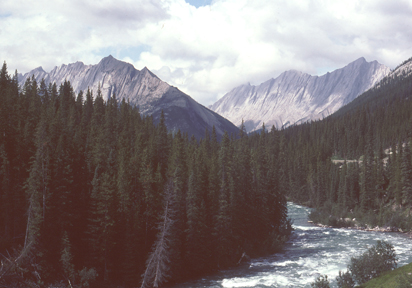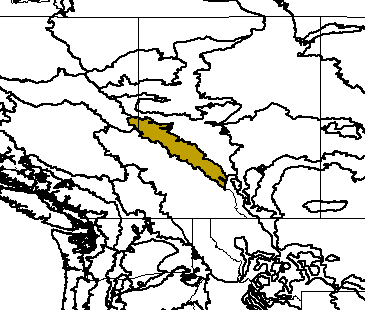
Jasper National Park, Alberta (c) 2005 Scott and Ruth Bassett
Bioimages home (click on an image to enlarge)
view
this page in its intended navigation context
Alberta Mountain forests
(WWF
ecoregion NA0501)

Jasper National Park, Alberta
(c)
2005 Scott and
Ruth Bassett

Source of bioregions data:
Olson, D. M. and
E. Dinerstein. The Global 200: Priority ecoregions for global conservation. (PDF
file) Annals of the Missouri Botanical Garden 89:125-126.
Distinctiveness (1=highest,4=lowest): 4
(nationally important)
This ecoregion has a high diversity of large mammals.*
Conservation Status (1=most endangered, 5=most
intact): 4 (relatively stable)
Approximately 80% of habitat remains intact. Road corridors and recreation
facilities are the main reason for habitat loss.*
 | Pinus contorta | (lodgepole pine) |
 | Picea engelmannii | (Engelmann spruce) |
 | Abies lasiocarpa | (subalpine fir) |
 Cervus
elaphus (elk)
Cervus
elaphus (elk) Ursus
acrtos (brown bear) (c) 2005
Carol and Steve Baskauf
Ursus
acrtos (brown bear) (c) 2005
Carol and Steve Baskauf  Rangifer
tarandus (caribou) (c) 2005
Carol and Steve Baskauf
Rangifer
tarandus (caribou) (c) 2005
Carol and Steve Baskauf  Oreamnos americanus (mountain
goat) (c) 2005
Daniel P. Duran
Oreamnos americanus (mountain
goat) (c) 2005
Daniel P. Duran
Associated habitats
Banff National Park, Alberta


vegetation
(c)
2005 Scott and
Ruth Bassett
hires
hires

Lake Louise
(c)
2005 Scott and
Ruth Bassett
hires

(c) 2005
Daniel P. Duran
hires
* Ricketts, T.H., E. Dinerstein, D.M. Olson, C.J. Loucks, et al. (1999) Terrestrial Ecoregions of North America: A Conservation Assessment. World Wildlife Fund - United States and Canada. Island Press, Washington, D.C. pp. 256-258.
Except as noted, images copyright 2002-2005 Steve Baskauf - Terms of use